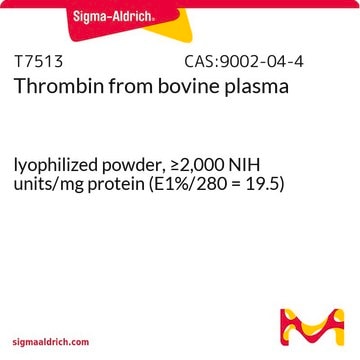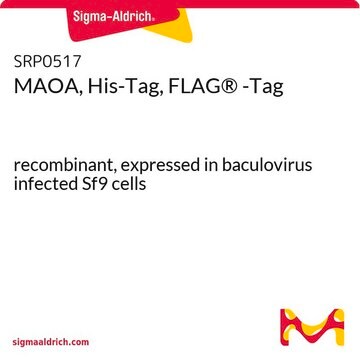SRP0676
Sortase A, S. aureus, His-tag
Staphylococcus aureus, recombinant, N-terminal His-Tag
Sinônimo(s):
SrtA, sortase A
Faça loginpara ver os preços organizacionais e de contrato
About This Item
Código UNSPSC:
41202061
Produtos recomendados
recombinante
expressed in E. coli
etiqueta
His tagged
forma
liquid
peso molecular
27.7 kDa
nº de adesão UniProt
temperatura de armazenamento
−70°C
Descrição geral
Our comprehensive portfolio of upstream process chemicals not only provides biopharmaceutical manufacturers with high-quality raw materials for production of classical and novel therapies, but also helps them get to market faster and simplify regulatory challenges. Trust us to deliver supply chain transparency and reliable sourcing around the globe, streamlining your product qualification with best-in-class regulatory support and service.
Aplicação
This product is suitable for in vitro ligation of proteins and peptides to other. Sortase A has been shown to create circularized proteins [1], as well as couple polypeptides to a wide range of substituents including polymers [2], lipids [3], fluorophores [4], sugars [5], microspheres [3], peptide nucleic acids [6], among others.
Ações bioquímicas/fisiológicas
Staphylococcal Sortase A is a bacterial transpeptidase that covalently links proteins to the bacterial cell wall by cleaving between threonine and glycine at an LPXTG recognition motif and catalyzes the formation of an amide bond between the carboxyl-group of threonine and the amino-group of the cell-wall peptidoglycan [7]. This chemistry can be exploited to site-specifically link proteins/peptides with the C-terminal LPETGX motif to other proteins or molecules possessing a glycine or aminomethylene motif [8].
forma física
Aqueous buffered solution containing: 40 mM Tris-HCl, pH 8.0, 110 mM NaCl, 2.2 mM KCl, 8 mM imidazole, 0.04% Tween-20, and 20% glycerol
Nota de análise
Analysis of this product can be performed in a reaction buffer (50 μl) containing 50 mM HEPES (pH=7.4), 150 mM NaCl, 5 mM CaCl2, 5 mM (Gly)3, 25 mM Abz/Dnp substrate, and Sortase A for 30 min at 30°C. Fluorescence intensity is measured at Ex320nm/Em420nm.
Código de classe de armazenamento
10 - Combustible liquids
Classe de risco de água (WGK)
WGK 2
Ponto de fulgor (°F)
Not applicable
Ponto de fulgor (°C)
Not applicable
Certificados de análise (COA)
Busque Certificados de análise (COA) digitando o Número do Lote do produto. Os números de lote e remessa podem ser encontrados no rótulo de um produto após a palavra “Lot” ou “Batch”.
Já possui este produto?
Encontre a documentação dos produtos que você adquiriu recentemente na biblioteca de documentos.
Hongyuan Mao et al.
Journal of the American Chemical Society, 126(9), 2670-2671 (2004-03-05)
Sortase (SrtA), a transpeptidase from Staphylococcus aureus, catalyzes a cell-wall sorting reaction at an LPXTG motif by cleaving between threonine and glycine and subsequently joining the carboxyl group of threonine to an amino group of pentaglycine on the cell wall
Stephan Pritz et al.
The Journal of organic chemistry, 72(10), 3909-3912 (2007-04-17)
Sortase A is a transpeptidase that cleaves at a pentapeptide-motif and subsequently transfers the acyl component to a nucleophile containing N-terminal oligoglycines. We investigate the reaction conditions of the sortase-mediated ligation and demonstrate a useful application by the synthesis of
John M Antos et al.
Journal of the American Chemical Society, 130(48), 16338-16343 (2008-11-08)
A general chemoenzymatic method for the site-specific attachment of lipids to protein substrates is described. Sortase A is used to append short lipid-modified oligoglycine peptides to the C terminus of protein substrates bearing a five amino acid sortase A recognition
Maximilian W Popp et al.
Proceedings of the National Academy of Sciences of the United States of America, 108(8), 3169-3174 (2011-02-08)
Recombinant protein therapeutics often suffer from short circulating half-life and poor stability, necessitating multiple injections and resulting in limited shelf-life. Conjugation to polyethylene glycol chains (PEG) extends the circulatory half-life of many proteins, but the methods for attachment often lack
Peptide-sugar ligation catalyzed by transpeptidase sortase: a facile approach to neoglycoconjugate synthesis.
Sharmishtha Samantaray et al.
Journal of the American Chemical Society, 130(7), 2132-2133 (2008-01-31)
Nossa equipe de cientistas tem experiência em todas as áreas de pesquisa, incluindo Life Sciences, ciência de materiais, síntese química, cromatografia, química analítica e muitas outras.
Entre em contato com a assistência técnica








